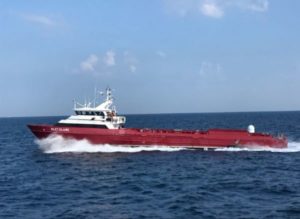The House Armed Services Seapower and Projection Forces subcommittee’s mark of the FY 2021 defense authorization bill would limit the Navy’s speed in producing unmanned vessels and limit retiring vessels as planned.
The subcommittee would prohibit procuring any large unmanned surface vessels (LUSVs) until a technology maturity certification is submitted to Congress. This limitation only expires 60 days after the Secretary of the Navy has submitted to the defense committees certification that the hull, mechanical, and electric systems have been developed and attained technology readiness levels of seven or higher and can be autonomously controlled for at least 30 days.

This also requires the command control system has been developed, can be operated autonomously, has reached technology readiness level seven and a detailed plan is developed for measuring and demonstrating the reliability of the vessel and all payloads. Moreover, those payloads must also have reached technology readiness level seven.
The provision also reiterated the subcommittee direction to limit LUSV weapons integration again.
“The Secretary of the Navy may not integrate any offensive weapon system into a large unmanned surface vessel until the date on which the Secretary of the Defense certifies to the congressional defense committees that any large unmanned surface vessel that employs offensive weapons will comply with the Law of Armed Conflict,” the mark said.
This comes after the Senate’s draft defense authorization bill sought similar measures. The Senate bill requires the Navy to qualify subsystems like main engines and generators for unmanned vessels before the service moves to vessel procurement (Defense Daily, June 11).
The Navy’s FY ’21 budget request already revamped the LUSV acquisition and development plan after being rebuked by Congress in the FY ’20 budget stating some of its plans were early to need, restricting buying new vessels, and restricting installing vertical launch tubes (Defense Daily, Feb. 14).
The Navy currently plans to only transition LUSV into a program of record in FY ’23, after the Navy buys two more Overlord-type prototype vessels, refines concepts of operations, and demonstrations the integration of key systems.
Committee staffers told reporters Monday the subcommittee recommends not funding the two additional prototypes until the program can show enough design maturity and understand autonomy. They said the committee is wary of moving to serial production too quickly with capabilities they do not completely understand using research and development funds, fearing the situation is too similar to how the Littoral Combat Ship (LCS) started with its own expensive flaws earlier in the program.
Separately, the Secretary of the Navy is prohibited from retiring, transferring, or placing in storage the USS Fort Worth (LCS-3) or USS Coronado (LCS-4), the third and fourth Littoral Combat Ships, until the Secretary of the Navy submits a certification that each mission module designed for the LCS has completed all operational tests.
This provision is in response to the Navy’s FY ’21 budget request planning to decommission the first four LCSs, which the service argued would save $1.2 billion over five years (Defense Daily, Feb. 10).
In March, Chief of Naval Operations Adm. Michael Gilday argued declining to upgrade the first four vessels to make them as operational as the rest of the class would cost $2 billion (Defense Daily, March 9).
The first LCSs currently serve as training vehicles and test assets, but the Navy’s request argued reallocating the funds and canceling vessel modernization “allows us to prioritize lethality and survivability where we need it.”
Gilday said the Navy’s request was a tough decision but ultimately decided “they’re not bringing capabilities to the fight and I didn’t see the return on investment to do that.”
The Navy has also planned to decommission four Ticonderoga-class Aegis cruisers to save $610 million over five years while accelerating the decommissioning of the Whidbey Island-class dock landing ships USS Germantown (LSD-42), Fort McHenry (LSD-43), and Gunston Hall (LSD-44). Those moves would save an estimated $844 million over five years.
The mark also generally prohibits retiring any nuclear-powered aircraft carrier before its first reactor refueling.
In 2019, the Navy initially planned to retire the USS. Harry S. Truman (CVN-75) decades earlier than planned while canceling its scheduled refueling and complex overhaul to redirect funds to new technologies like unmanned systems and directed energy weapons.
However, after consistent congressional pressure, the administration changed course and said CVN-75 would not be retired (Defense Daily, April 30, 2019).